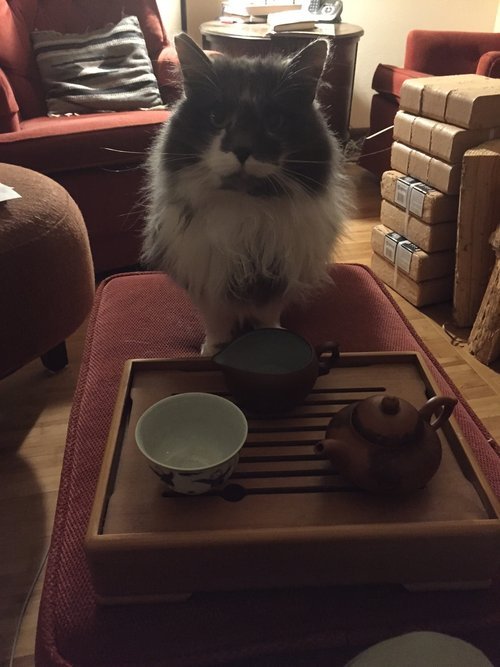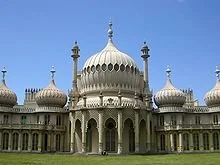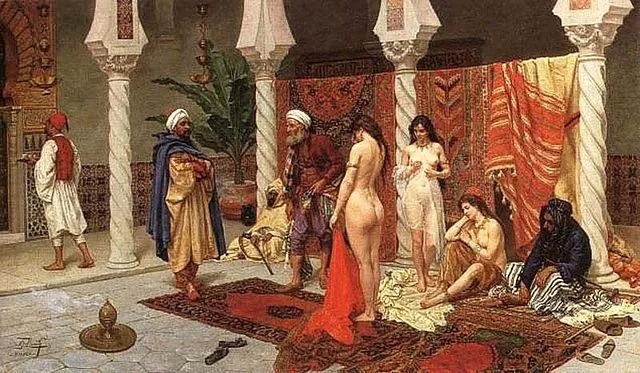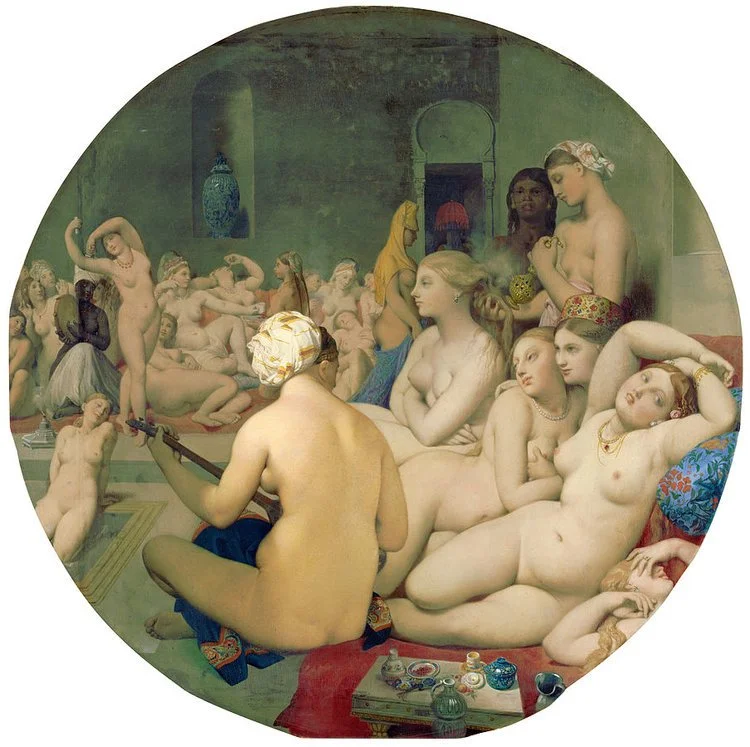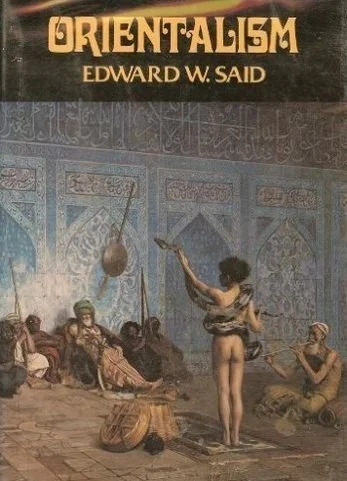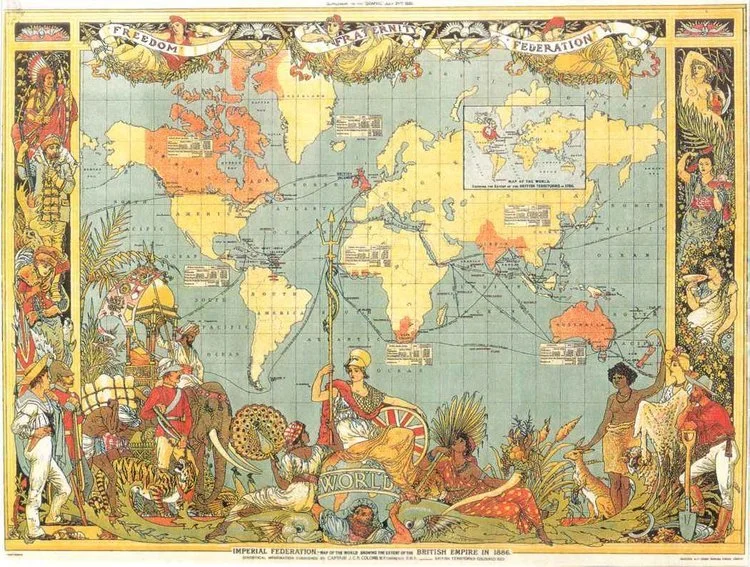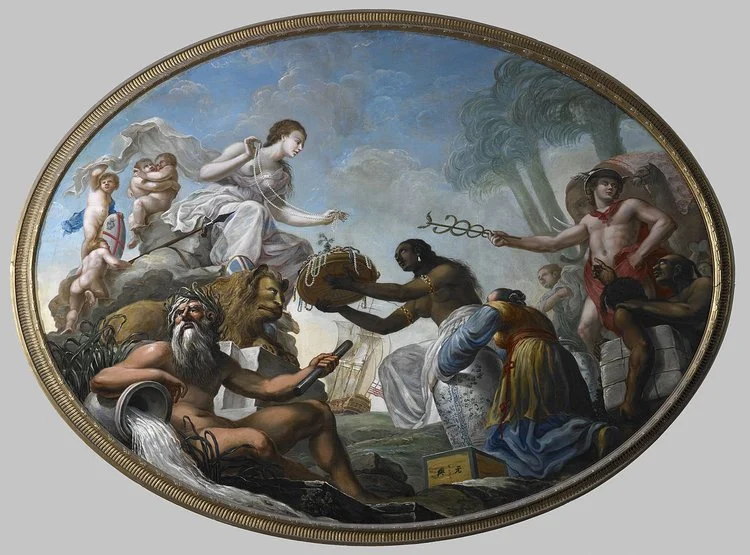Orientalism, Cultural Appropriation, and Critical Thinking
Originally published Jan 22, 2017
Here I am, in front of my wood stove, with a kitty snoring away on my lap. As part of my daily non-negotiable writing ritual, I am enjoying some fancy Puer tea, which I have ceremoniously prepared by carefully pouring water of just the right temperature onto the delicate leaves in their special Chinese Yixing tea pot, contained on my special Chinese bamboo tea tray, to be poured at just the right moment from my tea pot into my special fancy tea pitcher, and from there into my special antique Chinese porcelain cup, before I smell it and then imbibe it, drop by drop, with a sigh of contentment. All my accoutrements have been selected with great love and care on various trips to China and Taiwan, some stemming back to my first stint in Taiwan almost 30 years ago. Determined to write a blog about Orientalism that has been on my mind for months at this point, I am forced to wonder: Is my daily reenactment of the Chinese tea ceremony, sometimes following a meditation session with incense or accompanied by Chinese Guzheng music playing softly in the background, a silly act of Orientalism or is it simply a reflection of my lifelong engagement with a foreign culture whose ancient philosophical, religious, medical, literary, and aesthetic contributions I have studied and treasured since my first day in college? Obviously the answer is not all that important to me because I love my tea anyway and can’t write without it. But I believe that it is a useful question to contemplate…
Before you read this entire blog in hope of an answer at the end, I will tell you right from the start that I have to disappoint you and don’t have such an answer. All I can offer is some information that may stimulate you to think about this term from a slightly different perspective. Especially if you are one of the many often well-meaning people in our profession who still defend the use of the term in the context of “Oriental Medicine” or the intellectual approach associated with it.
In addition, I also do not feel like I am the best person to be writing this blog. One of the first classes I ever taught at the University of Arizona in my graduate student days was, after all, a class called “Asian Religions,” forcing me as a student of East Asian Studies to brush over the vast differences between Indian and East Asian religious expressions. While the story of Buddhism’s influence on China (and from there on Korea, Japan, and Vietnam) and China’s influence on Buddhism is certainly fascinating and worthy of a course of its own, I never felt like I could do justice to Indian religion. For me as a sinologist, Indian religion and philosophy is quite a foreign system of thought, as it is rooted in an Indo-European background rather than in my own specialty of East Asia. Much has happened in academia, especially in the field of Post-Colonial Studies, since I graduated, and I keep hoping that it simply may no longer be necessary for me to address this issue in writing, but I keep getting forced into intellectual arguments with students and colleagues in our profession who continue to defend the term and the intellectual approach associated with it. You will see below what I mean by that. So I hope that I can shortcut some of these arguments and inspire a sensitivity to this problem in students and practitioners by pulling together some resources and putting my thoughts in writing in a more careful and methodical manner.
I have tried for months, unsuccessfully, to recruit one of my more academically sophisticated friends and colleagues to write a guest blog on this topic for me. I wonder why nobody has taken the bait? At this point, though, I have spent far too long searching for a short introduction to the topic that manages to communicate to my students in Chinese medicine school why they need to be familiar with this term and with the problematic attitude that it represents in the eyes of those who find it offensive. This is particularly pertinent given the fact that my students will still be earning a degree of Master or Doctor of “Oriental Medicine.” After a week and a half of being snowed and iced in at my home outside of Portland, Oregon, in an epic winter storm, I am hoping to make some good use of my time with this blog, which is intended to also serve as one part of a writing assignment for my students for their first class in a “Chinese History and Culture” class that we all missed last week due to this historic storm. I know I am bound to put my foot in my mouth here, and I know there must be many ways of addressing this thorny topic more elegantly or succinctly than I am capable of doing. Nevertheless, this is a topic that needs to be addressed in such a way as to bridge the unfortunate deep chasm between the clinical world of Chinese medicine as a professional practice and basis for self-cultivation, and the knowledge produced in what many CM practitioners especially in the US far too often condemn as “ivory-tower” academia and therefore choose to ignore. What follows here is an attempt to help those of you on the clinical medicine side understand why not only academics, but a growing majority of other educated people in the English-speaking world, find the term, concept, and intellectual approach associated with Orientalism offensive, misleading, outdated, and counter-productive.
As reported in the Huffington Post on May 23, 2016, Obama signed a bill that week to eliminate what the newspaper called “the offensive and outdated descriptors” Oriental and Negro from federal law in a move with broad bipartisan support. As explained to the newspaper by Mee Moua, Director of Asian Americans Advancing Justice, “‘Oriental’ is derogatory because it objectifies Asian-Americans, as if we were rugs. Plus, the term is weirdly directional. It makes ‘The Orient’ into this foreign, exotic place, but it’s only ‘far away’ if you’re from the West. That’s pretty alienating.” As a result, all references to “Oriental” and “Negro” have been replaced in federal legislation by the words “Asian-American” and “African-American,” respectively. While nobody has risen up to defend the use of “Negro” (or “Indian” or “Eskimo,” which were also included in the bill), for some reason many people in our profession continue to proudly identify their medicine as “Oriental” and respond with defensiveness when the issue of “Orientalism” is raised, both as a linguistic issue and as a critique of an intellectual and epistemological approach.
Orientalism is a term and topic that has crept into my thoughts repeatedly over the last few months. I have tried to push this unwanted visitor back out the door, with excuses ranging from “Everything there is to say on the topic has already been said by much smarter, more erudite people than myself,” to “This is just another example of me sticking my foot in my mouth and stirring up a hornets’ nest with no need,” to “Who am I to say anything about this topic, because wasn’t it this very same fascination with the ‘Orient’ that got me started in the field of sinology in the first place?” But alas, the term has gotten a foot in the door and a draft of this blog post has been sitting on my desktop for months now, waiting for me to accept the challenge. Please forgive me if I offend you, dear reader. I’d rather step on your toes than continue tiptoeing around the subject, remaining silent, and smoldering internally as I witness this attitude rearing its ugly head again and again in innocent statements by the most well-meaning people who simply have never critically thought about its historical baggage in the context of learning, practicing, or teaching what is far too often still tellingly called “Oriental Medicine.” If nothing else, I hope to revive or stir up a conversation in our profession that happened in academia a long time ago but apparently went unnoticed in the field of clinical Chinese medicine:
The problem of Orientalism in our profession grabbed my attention forcefully a few months ago as I was teaching a “Capstone Project Tutorial” to prepare our doctoral candidates at the National University of Natural Medicine’s College of Classical Chinese Medicine in Portland, Oregon for their doctoral capstone during their final year. I take my role and responsibility in this part of the students’ education very seriously. I consider it a great honor to be actively involved in what is meant to be the culmination and crowning expression of their knowledge in Classical Chinese Medicine, gained in four or five arduous years of a personally, academically, and clinically challenging education. Whether by coincidence or as a general trend, I noticed this year a disturbing tendency in student work to approach the information presented in classes and readings from an attitude that I choose to describe here by the term “Orientalist.” After defining Orientalism below, the reader will hopefully have gained a better understanding of what I mean by that. I will then elaborate on my use of the term here in reference specifically to my students’ writings, and provide some concrete examples. More recently, two of my grading assistants and I were struck repeatedly by what we once again agreed was an Orientalist tendency in weekly reflection papers, which stimulated me to now write this blog and incorporate a critical discussion of Orientalism in my introductory lecture for our first-year Chinese medicine students. What do we intend to communicate when we use this term in the context of critiquing a certain attitude expressed in the writings of Chinese medicine students, or even in the expressions by practitioners or senior teachers for that matter?
Here is a brief definition on “Orientalism,” pulled straight from Wikipedia rather than from some obscure echo chamber in the academic ivory tower, to start the conversation. I am intentionally presenting a popular description, to contextualize my own definition in light of the popular uses of the term. The Wikipedia entry begins with a description of its use by art historians in particular to describe the work of “writers, designers, and artists from the West,” unfortunately with no time frame, in depicting what they considered “Oriental” cultures, especially in the nineteenth century.
Orientalism is a term used by scholars in art history, literary, geography, and cultural studies for the depiction of Eastern, that is "Oriental" cultures, including Middle Eastern, North African, South Asian and Southeast Asian cultures, done by writers, designers, and artists from the West. In particular, Orientalist painting depicting "the Middle East" was a genre of 19th-century Academic art. The literature of Western countries took a similar interest in Oriental themes. It is also used for the use of Asian styles in Western art, especially in architecture and the decorative arts.
Giulio Rosati, Inspection of New Arrivals, 1858–1917, Circassian beauties being inspected
In the more detailed discussion of French and British “Orientalist” art following the general description, this Wikipedia entry points out the prevalence of “lassitude and visual spectacle,” and the often “salacious” depictions of scenes in harems and slave markets in particular. Please visit the website for a slew of exemplary paintings by French and British artists.
Jean Auguste Dominique Ingres, The Turkish Bath, 1862
The article then describes the use of “Oriental” in the academic context, which I believe to be the root for the use of “Oriental” in the name of our medical profession. While still occasionally used in academia when I started my studies, it is here correctly (in my humble opinion) consigned to the dust bin of past centuries:
In the 18th and 19th centuries, the term Orientalist identified a scholar who specialized in the languages and literatures of the Eastern world. …The academic field of Oriental studies, which comprehended the cultures of the Near East and the Far East, became the fields of Asian studies and Middle Eastern studies.
Lastly, the article introduces the most common contemporary use of the term, which was influenced greatly by the publication of Edward Said’s ground-breaking and controversial book Orientalism.
… In the book Orientalism (1978), the cultural critic Edward Said redefined the term Orientalism to describe a pervasive Western tradition — academic and artistic — of prejudiced outsider-interpretations of the Eastern world, which was shaped by the cultural attitudes of European imperialism in the 18th and 19th centuries.[12] The thesis of Orientalism develops Antonio Gramsci’s theory of cultural hegemony, and Michel Foucault's theorisation of discourse (the knowledge-and-power relation) to criticise the scholarly tradition of Oriental studies. … The praxis of cultural imperialism reduces (essentializes) those societies as culturally static and intellectually undeveloped; the fabrication of cultural superiority is that Oriental culture is a thing (an Other) that can be studied, depicted, and reproduced. Implicit to the orientalist fabrication is the culturally opposite idea that Western society is developed, rational, flexible, and thereby superior, whilst Oriental societies are inferior for being undeveloped, irrational, and inflexible.
Let us now move beyond these popular definitions and explore Said’s critique of Orientalism in more depth. In a discussion on Orientalism in an undergraduate lecture on British Indian History that serves as an introduction to the course, the Indian-born writer and professor of History and Asian American Studies at UCLA Vinay Lal emphasizes that Orientalist discourse does not tell us anything about the “Orient,” whatever that artificial construct by Western scholars at the height of the colonialist period may even mean. Rather, it provides insight about the intellectual milieu of the people who created that discourse and who created the very notion of an “Orient,” or in a slightly more politically correct, contemporary version, “the East” as an essentialized Other in opposition to the “Occident” or “the West.” According to Professor Lal, “Orientalism purports to be a way of understanding the Other, although in fact it may be the only way in which the West understood itself. It had to create a radical difference between itself and something called ‘the Other.’” In my mind, Professor Lal’s greatest contribution to our discussion here may be this series of questions he asks his undergraduate students:
Orientalism, very broadly, is about the politics of representation. Who represents whom with what authority, with what right, and with what consequences? Who speaks for whom?
In this context, it is highly significant to Lal that Orientalism as an intellectual enterprise is a product of the eighteenth century, which was the heyday of colonialism and enlightenment, created by Western scholars in a colonialist context. These scholars projected onto a supposedly mysterious, exotic East the opposite of what they considered their own Western civilization to stand for, from breastfeeding regimens to hygiene to military training, cricket, and proper table manners. As Lal points out, Orientalism is not simply a set of prejudices, since it is human nature to have prejudices about the Other.
Not all prejudices are equally harmful. White people have prejudices about black people and black people have prejudices about white people…However, the two are not equivocal, because the prejudices of white people have an institutional backing. They have consequences for black people…. If in the 18th century, white people have prejudices against Indians…, those prejudices have consequences. If a Hindu thinks, this Englishman, he stinks because he doesn’t take a daily bath, what effect does it have, because who is governing whom?...What Said is saying is that in the 18th century a very particular relationship developed between power and knowledge, and it developed under the conditions of colonialism, where an entire intellectual apparatus was created for representing the Other, and academic disciplines, organizations, entire societies were complicit in this enterprise. So this is a systematic way, it’s not a matter of an individual here and there.
In other words, it is essential that we recognize the power relationships, hidden agendas, and real-life consequences for the people living in this “Orient” of the knowledge that was produced by white Europeans as the result of an Orientalist attitude towards the East under the influence of a colonialist power structure in the British and French, and to a lesser extent Portuguese, Spanish, and German empires.
Of course you may challenge me now by questioning the relevance of these critiques for contemporary information about East Asia, and about Chinese medicine in particular. Orientalism was first used, after all, to refer to artistic representations of what we would now call the Near East and parts of Africa, was centered in Edward Said’s critique on the political circumstances in the Middle East, and is discussed by Vinay Lal in the context of the British history in India. Why on earth can’t we leave that discussion behind and simply embrace the term as a value-free sanitized reference, in our field of medicine, to describe knowledge from “The East,” which is what our medicine is supposed to stand for after all?
Given that Chinese medicine was not just created by Chinese, but also influenced heavily by Japanese, Korean, and Vietnamese practitioners and scholars, and is now being practiced and taught and further developed by actors world-wide, calling it “Chinese” strikes many Asian but non-Chinese participants as offensive and exclusionary. An article by Will Morris in the journal Acupuncture Today from 2007, for example, asks, “Is Asian More Pejorative than Oriental?”. So one reason why this term is still in use in our profession that is cited by some of its defendants is simply that we have not been able to come up with a better term. Others claim that "Oriental" may be offensive when referring to humans but not when referring to rugs or other artifacts, including Chinese medicine. Regardless of these arguments, my concern with the continued use of this term in reference to our medicine is related not so much to its linguistic offensiveness but to the intellectual attitude that it represents, namely an approach to various aspects of Chinese culture, including philosophy, religion, and medicine, that sees it as a mystical, spiritual, exotic, foreign, irrational, unknowable "Other." Moreover, it fails to distinguish it from other venerable medical traditions that are found in this so-called "Orient," most notably Ayurvedic and Tibetan medicine. As a licensed and regulated profession taught by accredited institutions and tested in state and federal board exams, the contemporary system of medicine that I prefer to call "Chinese medicine" but that is often referred to as "TCM," as it stands today, does not include these other traditional medicines in its officially approved curriculum, even though many practitioners include aspects like Tibetan singing bowl or Ayurvedic massage after they have received supplemental training in these areas.
"The East offering its riches to Britannia", painted by Roma Spiridone for the boardroom of the British East Asia Company.
